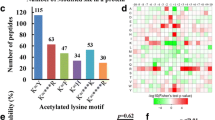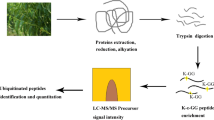Abstract
Protein ubiquitination is an evolutionarily conserved post-translational modification process in eukaryotes, and it plays an important role in many biological processes. Aspergillus nidulans, a model filamentous fungus, contributes to our understanding of cellular physiology, metabolism and genetics, but its ubiquitination is not completely revealed. In this study, the ubiquitination sites in the proteome of A. nidulans were identified using a highly sensitive mass spectrometry combined with immuno-affinity enrichment of the ubiquitinated peptides. The 4816 ubiquitination sites were identified in 1913 ubiquitinated proteins, accounting for 18.1 % of total proteins in A. nidulans. Bioinformatic analysis suggested that the ubiquitinated proteins associated with a number of biological functions and displayed various sub-cellular localisations. Meanwhile, seven motifs were revealed from the ubiquitinated peptides, and significantly over-presented in the different pathways. Comparison of the enriched functional catalogues indicated that the ubiquitination functions divergently during growth of A. nidulans and Saccharomyces cerevisiae. Additionally, the proteins in A. nidulans-specific sub-category (cell growth/morphogenesis) were subjected to the protein interaction analysis which demonstrated that ubiquitination is involved in the comprehensive protein interactions. This study presents a first proteomic view of ubiquitination in the filamentous fungus, and provides an initial framework for exploring the physiological roles of ubiquitination in A. nidulans.






Similar content being viewed by others
References
Benjamini Y, Yekutieli D (2001) The control of the false discovery rate in multiple testing under dependency. Ann Stat 29:1165–1188
Berepiki A, Lichius A, Read ND (2011) Actin organization and dynamics in filamentous fungi. Nat Rev Microbiol 9:876–887
Brown NA, dos Reis TF, Goinski AB, Savoldi M, Menino J, Almeida MT, Rodrigues F, Goldman GH (2014) The Aspergillus nidulans signalling mucin MsbA regulates starvation responses, adhesion and affects cellulase secretion in response to environmental cues. Mol Microbiol 94:1103–1120
Chen Z, Luo X, Lu Y, Zhu T, Wang J, Tsun A, Li B (2013) Ubiquitination signals critical to regulatory T cell development and function. Int Immunopharmacol 16:348–352
Chinnici JL, Fu C, Caccamise LM, Arnold JW, Free SJ (2014) Neurospora crassa female development requires the PACC and other signal transduction pathways, transcription factors, chromatin remodeling, cell-to-cell fusion, and autophagy. PLoS One 9:e110603
Colabardini AC, Humanes AC, Gouvea PF, Savoldi M, Goldman MHS, von Zeska Kress MR, Bayram Ö, de Castro Oliveira JV, Gomes MD, Braus GH (2012) Molecular characterization of the Aspergillus nidulans fbxA encoding an F-box protein involved in xylanase induction. Fungal Genet Biol 49:130–140
David H, Krogh AM, Roca C, Åkesson M, Nielsen J (2005) CreA influences the metabolic fluxes of Aspergillus nidulans during growth on glucose and xylose. Microbiology 151:2209–2221
Dikic I, Robertson M (2012) Ubiquitin ligases and beyond. BMC Biol 10:22
Galagan JE, Calvo SE, Cuomo C et al (2005) Sequencing of Aspergillus nidulans and comparative analysis with A. fumigates and A. oryzae. Nature 438:1105–1115
Glickman MH, Ciechanover A (2002) The ubiquitin-proteasome proteolytic pathway: destruction for the sake of construction. Physiol Rev 82:373–428
Hapala I, Griač P, Nosek J, Sychrová H, Tomáška L (2013) Yeast membranes and cell wall: from basics to applications. Curr Genet 59:167–169
Harris SD, Turner G, Meyer V, Espeso EA, Specht T, Takeshita N, Helmstedt K (2009) Morphology and development in Aspergillus nidulans: a complex puzzle. Fungal Genet Biol 46:S82–S92
Herranz S, Rodriguez JM, Bussink HJ, Sanchez-Ferrero JC, Arst HN, Penalva MA, Vincent O (2005) Arrestin-related proteins mediate pH signaling in fungi. Proc Natl Acad Sci USA 102:12141–12146
Hervás-Aguilar A, Peñalva MA (2010) Endocytic machinery protein SlaB is dispensable for polarity establishment but necessary for polarity maintenance in hyphal tip cells of Aspergillus nidulans. Eukaryot Cell 10:1504–1518
Hervás-Aguilar A, Galindo A, Peñalva MA (2010) Receptor-independent ambient pH signaling by ubiquitin attachment to fungal arrestin-like PalF. J Biochem 285:18095–18102
Karachaliou M, Amillis S, Evangelinos M, Kokotos AC, Yalelis V, Diallinas G (2013) The arrestin-like protein ArtA is essential for ubiquitination and endocytosis of the UapA transporter in response to both broad-range and specific signals. Mol Microbiol 88:301–317
Lamoth F, Juvvadi PR, Fortwendel JR, Steinbach WJ (2012) Heat shock protein 90 is required for conidiation and cell wall integrity in Aspergillus fumigates. Eukaryot Cell 11:1324–1332
Leach MD, Brown AJP (2012) Posttranslational modifications of proteins in the pathobiology of medically relevant fungi. Eukaryot Cell 11:98–108
Leach MD, Stead DA, Argo E, Brown AJ (2011) Identification of sumoylation targets, combined with inactivation of SMT3, reveals the impact of sumoylation upon growth, morphology, and stress resistance in the pathogen Candida albicans. Mol Biol Cell 22:687–702
Ling Q, Jarvis P (2013) Dynamic regulation of endosymbiotic organelles by ubiquitination. Trends Cell Biol 23:399–408
Lyzenga WJ, Stone SL (2012) Abiotic stress tolerance mediated by protein ubiquitination. J Exp Bot 63:599–616
Mayer MP, Le Breton L (2015) Hsp90: breaking the symmetry. Mol Cell 58:8–20
Noventa-Jordão MA, do Nascimento AM, Goldman MHS, Terenzi HF, Goldman GH (2000) Molecular characterization of ubiquitin genes from Aspergillus nidulans: mRNA expression on different stress and growth conditions. Biochim Biophys Acta 1490:237–244
Osherov N, May G (2000) Conidial germination in Aspergillus nidulans requires RAS signaling and protein synthesis. Genetics 155:647–656
Peng J, Schwartz D, Elias JE, Thoreen CC, Cheng D, Marsischky G, Roelofs J, Finley D, Gygi SP (2003) A proteomics approach to understanding protein ubiquitination. Nat Biotechnol 21:921–926
Röhrig J, Kastner C, Fischer R (2013) Light inhibits spore germination through phytochrome in Aspergillus nidulans. Curr Genet 59:55–62
Ronen R, Sharon H, Levdansky E, Romano J, Shadkchan Y, Osherov N (2007) The Aspergillus nidulans pkcA gene is involved in polarized growth, morphogenesis and maintenance of cell wall integrity. Curr Genet 51:321–329
Ruepp A, Zollner A, Maier D, Albermann K, Hani J, Mokrejs M, Tetko I, Güldener U, Mannhaupt G, Münsterkötter M, Mewes HW (2004) The FunCat, a functional annotation scheme for systematic classification of proteins from whole genomes. Nucleic Acids Res 32:5539–5545
Schnell JD, Hicke L (2003) Non-traditional functions of ubiquitin and ubiquitin-binding proteins. J Biol Chem 278:35857–35860
Stavreva DA, Kawasaki M, Dundr M, Koberna K, Müller WG, Tsujimura-Takahashi T, Komatsu W, Hayano T, Isobe T, Raska I, Misteli T, Takahashi N, McNally JG (2006) Potential roles for ubiquitin and the proteasome during ribosome biogenesis. Mol Cell Biol 26:5131–5145
Tamayo D, Muñoz JF, Torres I, Almeida AJ, Restrepo A, McEwen JG, Hernández O (2013) Involvement of the 90 kDa heat shock protein during adaptation of Paracoccidioides brasiliensis to different environmental conditions. Fungal Genet Biol 51:34–41
Teparić R, Mrsa V (2013) Proteins involved in building, maintaining and remodeling of yeast cell walls. Curr Genet 59:171–185
Todd RB, Davis MA, Hynes MJ (2007) Genetic manipulation of Aspergillus nidulans: meiotic progeny for genetic analysis and strain construction. Nat Protoc 2:811–821
Upadhyay S, Shaw BD (2008) The role of actin, fimbrin and endocytosis in growth of hyphae in Aspergillus nidulans. Mol Microbiol 68:690–705
Veide VJ, Dahal S, Ljungdahl T, Grøtli M, Tamás MJ (2014) Application of a peptide-based assay to characterize inhibitors targeting protein kinases from yeast. Curr Genet 60:193–200
Virag A, Lee MP, Si H, Harris SD (2007) Regulation of hyphal morphogenesis by cdc42 and rac1 homologues in Aspergillus nidulans. Mol Microbiol 66:1579–1596
Vizcaíno JA, Deutsch EW, Wang R et al (2014) ProteomeXchange provides globally co-ordinated proteomics data submission and dissemination. Nat Biotechnol 30:223–226
Xie X, Kang H, Liu W, Wang GL (2015) Comprehensive profiling of the rice ubiquitome reveals the significance of lysine ubiquitination in young leaves. J Proteome Res 14:2017–2025
Acknowledgments
We greatly appreciate Dr. Jianyi Pan (Zhejiang Sci-Tech University, Hangzhou, China) for his kind help with the data upload. This work was supported jointly by two Grants (31171898 and 31371990) from the National Natural Science Foundation of China.
Author information
Authors and Affiliations
Corresponding author
Ethics declarations
Conflict of interest
The authors declare that they have no conflict of interest.
Additional information
Communicated by M. Kupiec.
Electronic supplementary material
Below is the link to the electronic supplementary material.
Rights and permissions
About this article
Cite this article
Chu, XL., Feng, MG. & Ying, SH. Qualitative ubiquitome unveils the potential significances of protein lysine ubiquitination in hyphal growth of Aspergillus nidulans . Curr Genet 62, 191–201 (2016). https://doi.org/10.1007/s00294-015-0517-7
Received:
Revised:
Accepted:
Published:
Issue Date:
DOI: https://doi.org/10.1007/s00294-015-0517-7




